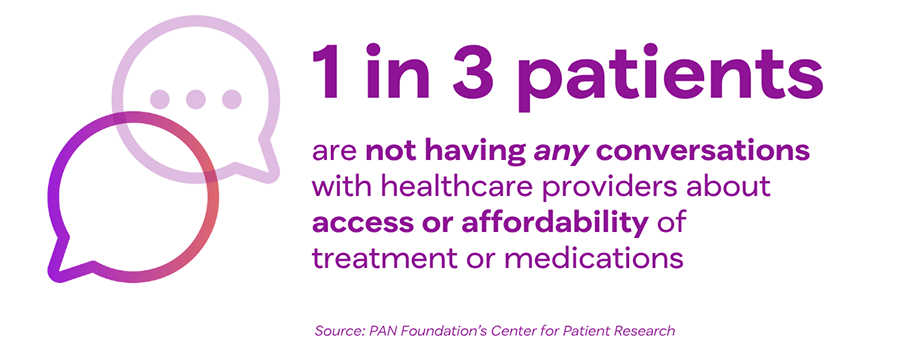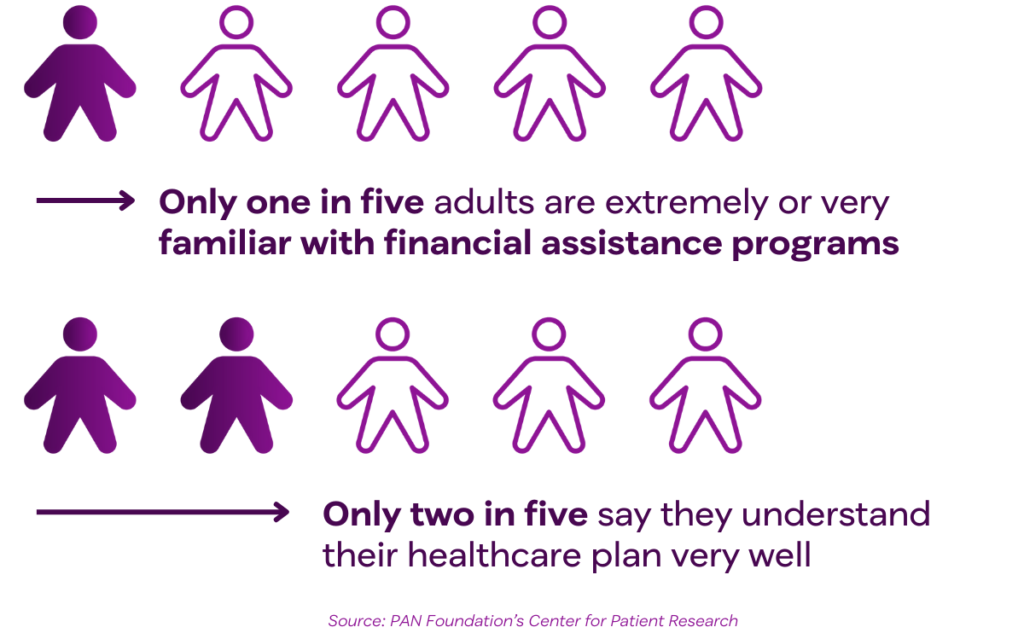Healthcare access insights from PAN’s Center for Patient Research in 2025: Part II
Now midway through 2025, PAN’s Center for Patient Research continues to conduct national polling to help capture a clearer understanding of the healthcare access and affordability issues patients face.
The data reveals consistent patterns that patients continue to struggle with affordability, access, and communication within the healthcare system. Over the past three months, we’ve released polls exploring the health insurance access barriers facing patients, the need for more communication between patients and providers, the low understanding of healthcare plans and financial assistance, and concerns about potential Medicaid cuts.
These insights help ensure the patient perspective and experience remains central to the education and advocacy work we do. As we move into the second half of 2025, our Center for Patient Research will continue to strive towards a better understanding of the patient healthcare experience and how we can create actionable change within our PAN community and beyond.
Patients facing more health insurance barriers to accessing care
PAN’s Center for Patient Research conducted a national poll, finding that more than one in three (35 percent) of adults with a chronic condition have faced barriers accessing their medication or treatment through their health insurance plan.
- One in three adults with a chronic condition report encountering insurance-related barriers more often in 2025 when compared to 2024, including increased cost-sharing (40 percent), formulary changes (37 percent), prior authorization (35 percent), and step therapy (32 percent).
- Among those who have experienced an insurance-related barrier this year, 66 percent report at least a mild impact on their ability to access their prescribed medications or treatments, with 35 percent reporting a severe or moderate impact.
- For 16 percent of adults with a chronic condition, these barriers have diminished their confidence in their ability to access their medications or treatments for the rest of 2025.
More conversations are needed between patients and providers about healthcare access and affordability
In May, PAN’s Center for Patient Research conducted a national poll which found about one in three patients (32 percent) are not having any conversations with their healthcare providers about their ability to access or afford their medications or treatments.

- Only 55 percent of patients report that their healthcare providers had conversations with them about both access and affordability issues.
- The most common programs healthcare providers discussed with patients when it comes to lowering their treatment costs included copay savings or prescription discount programs (23 percent), financial assistance programs from pharmaceutical programs (16 percent), and financial assistance programs from independent charitable foundations (14 percent).
- Nearly one in four patients (23 percent) did not have conversations with their healthcare providers about access and affordability issues because they did not believe their provider would be able to help them.
PAN patient research reveals low understanding of healthcare plans and financial assistance
In April, PAN’s Center for Patient Research released findings around patient understanding of their healthcare plans and financial assistance.

- Only two in five patients know whether their insurance plan uses common practices that prevent access to treatment and increase patient costs.
- About two in five U.S. adults (37 percent) and patients with a chronic condition (38 percent) understand their healthcare plan very well.
- Roughly 30 percent of U.S. adults and 37 percent of patients with a chronic condition needed financial assistance in the past year to help cover out-of-pocket healthcare expenses.
- Among those who needed financial assistance, 37 percent of U.S. adults and 41 percent of adults with a chronic condition did not end up receiving financial assistance.
Majority of Americans concerned about potential Medicaid cuts
In April, PAN’s Center for Patient Research also released national poll findings that most Americans polled said Medicaid cuts would impact their healthcare—and are unsure about how they will access services, from dental to hospice care.
- Among adults in the U.S. with experience or exposure to Medicaid or the Children’s Health Insurance Program (CHIP) benefits, 91 percent report potential cuts to Medicaid would have some impact on their ability to access needed healthcare services. Among those living with a chronic condition, the number is even higher at 93 percent.
- Nearly six in ten (57 percent) of adults with experience or exposure to Medicaid/CHIP report being extremely or very concerned about potential Medicaid cuts.
- Roughly 36-67 percent of adults with experience or exposure to Medicaid/CHIP thought certain mandatory services, such as physician services, inpatient hospital services, and laboratory and x-ray services, were optional for states to provide or were not sure they were mandatory.
About PAN’s Center for Patient Research
The PAN Foundation’s Center for Patient Research provides insights into the diverse needs of patients as they navigate the challenges of accessing affordable, equitable healthcare.
Through rigorous methodologies, we aim to understand the challenges faced by patients, translate these findings into actionable knowledge for healthcare stakeholders and policymakers, and help inform policies and educational opportunities leading to accessible, affordable, and equitable healthcare for all.

Stay connected with PAN
Sign up for email news from PAN and you’ll receive our patient-centered research reports, educational guides, advocacy action alerts, and more.
